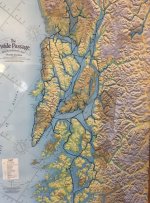Extra fuses, a spare macerator and water pump if you boats have these. Extra electrical wire and crimper, connectors and volt meter.
Spare prop (props), with castle nut, cotor pins and thrust washers. Water pump impeller. spare fuel filters. Extra gaskets for oil change, if necessary--both engine and lower unit. Spare hydraulic fluid if hydraulic steering.
Tool kit: including prop wrench, large and small crescent wrenches, Vise grips, including needle nose, large and small standard, and chain vice grips. Socket set, diagonal wire cutters, hardened or carbide jaws if fishing. Needle nose pliers, Screw drivers, including very small, Robertson, and zero clearance. ratchet type.
Self fusing tape, electrical and duct tape
Method of anchoring dinghy, or pulling it well up on shore.
Shrimp and crab pots, with adequate line (400 feet for Shrimp) Fishing gear.
I carry a folding shovel (German war surplus is far better than US), A hatchet, and machete. Large folding knife. Multi tool--such as Letterman Wave.
Extra anchor shackles, Stern anchor, and rode. I also carry a fortress sized to be a main anchor for sand and mud. Sufficient line to anchor in 100 feet of water. Tow line and bridle.
Shade for the forward hatch (sun doesn't go down until very late)
We carried HAM radio gear. The InReach (now by Garmin) for tracking and for sending 160 character messages via satellite.
Tablet with back up navigation (Navionics app). Definitely a Personal Locator Beacon (we have 3--one for each person and one for the ditch bag.)
Ditch bag: Multi tool, compact vinyl tarps and space blanket for each person. matches or lighter/fire starting material. rocket flares. compass--hand bearing. waterproof hand held VHF radio, with AA battery holder and at least a dozen AA batteries. Quality flashlight--with S O S, or ability to send S O S. Fishing package, first aid package, SS leader material with swages. Dacron line or paracord.
First Aid kit, to cover all contingencies where you may not get medical attention for a day or two.
Camper back enclosure. rain tight and bug screens. Insect repellant
Container spare water. Water purification tablets, or filter for contaminated water
We always carry a back up cooking (if a Wallas, then a single propane burner)
Be sure batteries are in good shape. Spare batteries for all devices on the boat-include AA AAA, 9V, Andy speciality batteries. I have a card of the small flat cells I carry--all types for about $3 at Ace.

